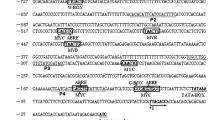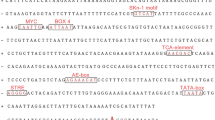Abstract
In genetic engineering, inducible promoters play an important role as the expression of genes driven by them can be turned on or off under situations like biotic or abiotic factors. There are few reports on inducible promoters that can be employed in the development of transgenic plants, particularly in sugarcane. In the present study, four wound inducible genes (Chitinase, PR1A, PR10 and HRGP) were selected and were amplified from Erianthus arundinaceus, a distant relative of sugarcane. In order to determine the gene that is highly induced upon wounding, RT-qPCR was performed, which showed that PR10 gene expression was instantaneous and higher upon wounding when compared to the other three genes. Using the random amplification of genomic ends technique, a 592 bp promoter sequence was obtained and in silico analysis of the upstream regulatory region revealed a 469 bp promoter and 123 bp of 5′ untranslated region (UTR). Functional analyses of the promoter sequence (with and without 5′ UTR) in tobacco, rice and sugarcane using β-glucuronidase (GUS) as the reporter gene revealed the constitutive and inducible nature of the PR10 promoter. Our studies have demonstrated that the PR10 promoter, though highly constitutive, was quickly induced upon wounding as well as on treatment with abscisic acid and methyl jasmonate hormones. This is the first report on the isolation and characterization of a PR10 promoter from a wild grass and is expected to have application for development of transgenic plants.










Similar content being viewed by others
References
Potenza C, Aleman L, Sengupta-Gopalan C (2004) Targeting transgene expression in research, agricultural, and environmental applications: promoters used in plant transformation. In Vitro Cell Dev Biol Plant 40(1):1–22
van Loon LC, Rep M, Pieterse CM (2006) Significance of inducible defense-related proteins in infected plants. Annu Rev Phytopathol 44:135–162
Zeevaart JAD, Creelman RA (1988) Metabolism and physiology of abscisic acid. Annu Rev Plant Physiol Plant Mol Biol 39:439–473
Reymond P, Farmer EE (1998) Jasmonate and salicylate as global signals for defense gene expression. Curr Opin Plant Biol 1:404–411
Turner JG, Ellis C, Devoto A (2002) The jasmonate signal pathway. Plant Cell 14(Suppl):S153–S164
Delessert C, Wilson I, Van Der Straeten D, Dennis E, Dolferus R (2004) Spatial and temporal analysis of the local response to wounding. Plant Mol Biol 55(2):165–181
Livak KJ, Schmittgen TD (2001) Analysis of relative gene expression data using real-time quantitative PCR and the 2−ΔΔCt method. Methods 25:402–408
Kuriakose B, Ganesan V, Thomas G, Viswanathan A, Anand N (2009) Random amplification of genomic ends (RAGE) as an efficient method for isolation and cloning of promoters and uncloned genomic regions. Afr J Biotechnol 8(19):4765–4773
Philip A, Syamaladevi DP, Chakravarthi M, Gopinath K, Subramonian N (2013) 5′ Regulatory region of ubiquitin 2 gene from Porteresia coarctata makes efficient promoters for transgene expression in monocots and dicots. Plant Cell Rep 32(8):1199–1210
Higo K, Ugawa Y, Iwamoto M, Korenaga T (1999) Plant cis-acting regulatory DNA elements (PLACE) database: 1999. Nucl Acids Res 27:297–300
Shannon P, Markiel A, Ozier O, Baliga NS, Wang JT, Ramage D, Amin N, Schwikowski B, Ideker T (2003) Cytoscape: a software environment for integrated models of biomolecular interaction networks. Genome Res 13:2498–2504
Kumar KK, Maruthasalam S, Loganathan M, Sudhakar D, Balasubramanian P (2005) An improved Agrobacterium-mediated transformation protocol for recalcitrant elite indica rice cultivars. Plant Mol Biol Rep 23(1):67–73
Horsch RB, Fry JE, Hoffman NL, Eicholtz D, Rogers SG, Fraley RT (1985) A simple and general method for transferring genes into plants. Science 227:1229–1231
Arvinth S, Arun S, Selvakesavan RK, Srikanth J, Mukunthan N, Kumar PA, Premachandran MN, Subramonian N (2010) Genetic transformation and pyramiding of aprotinin-expressing sugarcane with cry1Ab for shoot borer (Chilo infuscatellus) resistance. Plant Cell Rep 29(4):383–395
Jefferson RA, Kavanagh TA, Bevan MW (1987) GUS fusions: beta glucuronidase as a sensitive and versatile gene fusion marker in higher plants. EMBO J 6:3901–3907
Curtis MD, Rae AL, Rusu AG, Harrison SJ, Manners JM (1997) A peroxidase gene promoter induced by phytopathogens and methyl jasmonate in transgenic plants. Mol Plant-Microbe Interact 10(3):326–338
Eulgem T, Rushton PJ, Robatzek S, Somssich IE (2000) The WRKY superfamily of plant transcription factors. Trends Plant Sci 5(5):199–206
Xu X, Chen C, Fan B, Chen Z (2006) Physical and functional interactions between pathogen-induced Arabidopsis WRKY18 WRKY40 and WRKY60 transcription factors. Plant Cell 18(5):1310–1326
Nishiuchi T, Shinshi H, Suzuki K (2004) Rapid and transient activation of transcription of the ERF3 gene by wounding in tobacco leaves: possible involvement of NtWRKYs and autorepression. J Biol Chem 279(53):55355–55361
Brown RL, Kazan K, McGrath KC, Maclean DJ, Manners JM (2003) A role for the GCC-box in jasmonate-mediated activation of the PDF12 gene of Arabidopsis. Plant Physiol 132(2):1020–1032
Maeda K, Kimura S, Demura T, Takeda J, Ozeki Y (2005) DcMYB1 acts as a transcriptional activator of the carrot phenylalanine ammonia-lyase gene (DcPAL1) in response to elicitor treatment, UV-B irradiation and the dilution effect. Plant Mol Biol 59(5):739–752
Benfey PN, Chua N-H (1990) The cauliflower mosaic virus 35S promoter: combinatorial regulation of transcription in plants. Science 250:959–966
Rogers HJ, Bate N, Combe J, Sullivan J, Sweetman J, Swan C, Lonsdale DM, Twell D (2001) Functional analysis of cis-regulatory elements within the promoter of the tobacco late pollen gene g10. Plant Mol Biol 45(5):577–585
Stalberg K, Ellerstom M, Ezcurra I, Ablov S, Rask L (1996) Disruption of an overlapping E-box/ABRE motif abolished high transcription of the napA storage-protein promoter in transgenic Brassica napus seeds. Planta 199(4):515–519
Gowik U, Burscheidt J, Akyildiz M, Schlue U, Koczor M, Streubel M, Westhoff P (2004) cis-Regulatory elements for mesophyll-specific gene expression in the C4 plant Flaveria trinervia the promoter of the C4 phosphoenolpyruvate carboxylase gene. Plant Cell 16(5):1077–1090
Sandal NN, Bojsen K, Marcker KA (1987) A small family of nodule specific genes from soybean. Nucleic Acids Res 15(4):1507–1519
Kim HJ, Kim YK, Park JY, Kim J (2002) Light signalling mediated by phytochrome plays an important role in cold-induced gene expression through the C-repeat/dehydration responsive element (C/DRE) in Arabidopsis thaliana. Plant J 29(6):693–704
Hudson ME, Quail PH (2003) Identification of promoter motifs involved in the network of phytochrome A-regulated gene expression by combined analysis of genomic sequence and microarray data. Plant Physiol 133:1605–1616
Grotewold E, Drummond BJ, Bowen B, Peterson T (1994) The myb homologous P gene controls phlobaphene pigmentation in maize floral organs by directly activating a flavonoid biosynthetic gene subset. Cell 76(3):543–553
Sablowski RW, Moyano E, Culianez-Macia FA, Schuch W, Martin C, Bevan M (1994) A flower-specific Myb protein activates transcription of phenylpropanoid biosynthetic genes. EMBO J 13(1):128
Abe H, Urao T, Ito T, Seki M, Shinozaki K, Yamaguchi-Shinozaki K (2003) Arabidopsis AtMYC2 (bHLH) and AtMYB2 (MYB) function as transcriptional activators in abscisic acid signaling. Plant Cell 15(1):63–78
Simpson SD, Nakashima K, Narusaka Y, Seki M, Shinozaki K, Yamaguchi-Shinozaki K (2003) Two different novel cis-acting elements of erd1 a clpA homologous Arabidopsis gene function in induction by dehydration stress and dark-induced senescence. Plant J 33:259–270
Shirsat A, Wilford N, Croy R, Boulter D (1989) Sequences responsible for the tissue specific promoter activity of a pea legumin gene in tobacco. Mol Gen Genet 215:326–331
Yanagisawa S (2000) Dof1 and Dof2 transcription factors are associated with expression of multiple genes involved in carbon metabolism in maize. Plant J 21(3):281–288
Ohme-Takagi M, Shinshi H (1995) Ethylene-inducible DNA binding proteins that interact with an ethylene-responsive element. Plant Cell 7(2):173–182
Rouster J, Leah R, Mundy J, Cameron-Mills V (1997) Identification of a methyl jasmonate-responsive region in the promoter of a lipoxygenase 1 gene expressed in barley grain. Plant J 11:513–523
Shinozaki K, Yamaguchi-Shinozaki K (1996) Molecular responses to drought and cold stress. Curr Opin Biotechnol 7:161–167
Somssich IE, Schmelzer E, Kawalleck P, Hahlbrock K (1988) Gene structure and its in situ transcript localization of pathogenesis related protein 1 in parsley. Mol Gen Genet 213(1):93–98
Schmelzer E, Kruger-Lebus S, Hahlbrock K (1989) Temporal and spatial patterns of gene expression around sites of attempted fungal infection in parsley leaves. Plant Cell 1:993–1001
Warner SA, Scott R, Draper J (1992) Characterization of a wound-induced transcript from the monocot asparagus that shares similarity with a class of intracellular pathogenesis related (PR) proteins. Plant Mol Biol 19:555–561
Lo SCC, Hipskind JD, Nicholson RL (1999) cDNA cloning of a sorghum pathogenesis-related protein (PR-10) and differential expression of defense-related genes following inoculation with Cochliobolus heterostrophus or Colletotrichum sublineolum. Mol Plant-Microbe Interact 12:479–489
Handschuh L, Femiak I, Kasperska A, Figlerowicz M, Sikorski MM (2007) Structural and functional characteristics of two novel members of pathogensis-related multigene family of class 10 from yellow lupine. Acta Biochim Pol 54(4):783–796
Lu J, Sivamani E, Azhakanandam K, Samadder P, Li X, Qu R (2008) Gene expression enhancement mediated by the 5′ UTR intron of the rice rubi3 gene varied remarkably among tissues in transgenic rice plants. Mol Genet Gen 279:563–572
Samadder P, Sivamani E, Lu J, Li X, Qu R (2008) Transcriptional and post-transcriptional enhancement of gene expression by the 5′ UTR intron of rice rubi3 gene in transgenic rice cells. Mol Genet Genomics 279:429–439
Rakwal R, Agrawal GK, Yonekura M (2001) Light-dependent induction of OsPR10 in rice (Oryza sativa L.) seedlings by the global stress signaling molecule jasmonic acid and protein phosphatase 2A inhibitors. Plant Sci 161:469–479
Wang CS, Huang JC, Hu JH (1999) Characterization of two subclasses of PR-10 transcripts in lily anthers and induction of their genes through separate signal transduction pathways. Plant Mol Biol 40:807–814
McGee JD, Hamer JE, Hodges TK (2001) Characterization of a PR-10 pathogenesis-related gene family induced in rice during infection with Magnaporthe grisea. Mol Plant-Microbe Interact 14:877–886
Jwa NS, Kumar AG, Rakwal R, Park CH, Prasad AV (2001) Molecular cloning and characterization of a novel Jasmonate inducible pathogenesis-related class 10 protein gene, JIOsPR10, from rice (Oryza sativa L.) seedling leaves. Biochem Biophys Res Commun 286:973–983
Zhou XJ, Lu S, Xu YH, Wang JW, Chen XY (2002) A cotton cDNA (GaPR-10) encoding a pathogenesis-related 10 protein with in vitro ribonuclease activity. Plant Sci 162:629–636
Kim ST, Yu S, Kang YH, Kim SG, Kim JY, Kim SH, Kang KY (2008) The rice pathogen-related protein 10 (JIOsPR10) is induced by abiotic and biotic stresses and exhibits ribonuclease activity. Plant Cell Rep 27(3):593–603
Hwang SH, Lee IA, Yie SW, Hwang DJ (2008) Identification of an OsPR10a promoter region responsive to salicylic acid. Planta 227(5):1141–1150
Bahramnejad B, Goodwin PH, Zhang J, Atnaseo C, Erickson LR (2010) A comparison of two class 10 pathogenesis-related genes from alfalfa and their activation by multiple stresses and stress-related signaling molecules. Plant Cell Rep 29(11):1235–1250
Acknowledgments
The authors would like to thank the Indian Council of Agricultural Research, New Delhi and Sugarcane Breeding Institute, Coimbatore, India for the funding and infrastructure.
Author information
Authors and Affiliations
Corresponding author
Rights and permissions
About this article
Cite this article
Chakravarthi, M., Syamaladevi, D.P., Harunipriya, P. et al. A novel PR10 promoter from Erianthus arundinaceus directs high constitutive transgene expression and is enhanced upon wounding in heterologous plant systems. Mol Biol Rep 43, 17–30 (2016). https://doi.org/10.1007/s11033-015-3934-2
Received:
Accepted:
Published:
Issue Date:
DOI: https://doi.org/10.1007/s11033-015-3934-2




